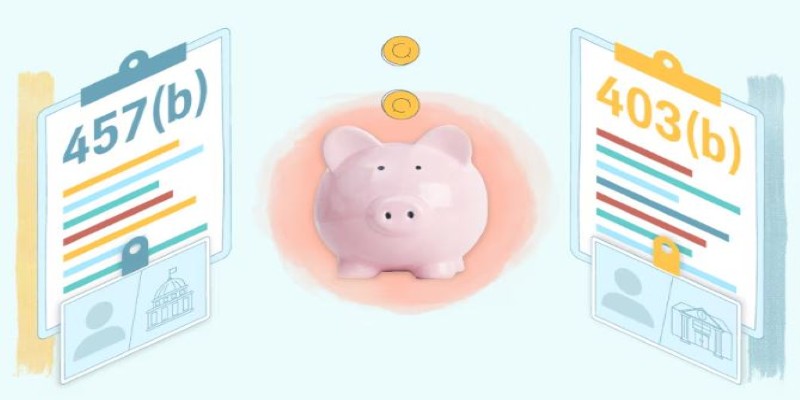Should You Choose a 403(b) or 457(b) for Retirement Savings
Retirement planning can be tricky, especially when deciding between 403(b) and 457(b) plans. Both offer tax benefits and are available to employees in public sector jobs, but they serve different purposes. A 403(b) is for employees of public schools, churches, and non-profits, functioning similarly to a 401(k) with pre-tax contributions that grow tax-deferred.
A 457(b), which is for state and local government workers and certain non-profits, also provides pre-tax savings but with special withdrawal provisions and catch-up contributions. Choosing between the two will depend on your retirement objectives and employer plan. Let's discuss the major differences and how to maximize your savings with both.
How Do 403(b) and 457(b) Plans Work?
A 403(b) plan operates in much the same way as a standard 401(k), with employees able to contribute pre-tax dollars, lowering their income tax. The contributions are tax-deferred, so the taxes are not paid until the funds are removed at retirement. Employers often match the contributions, adding yet another benefit.
A 457(b) is a deferred compensation plan that is mostly for government and non-profit employees. Similar to the 403(b), it enables pre-tax contributions that lower taxable income. Still, it has its characteristics, such as no penalty for early withdrawal if you are fired or leave your employer before retirement age. This leeway is an important benefit for people who can expect to withdraw their funds prior to the regular retirement age.
Both plans include yearly contribution limits, which are presently $23,000 for people under the age of 50. Individuals above 50 years are allowed to make catch-up contributions. The 457(b) has a unique catch-up rule that permits workers nearing retirement to contribute more.
The primary distinction is withdrawal flexibility. Although 403(b) plans charge a 10% early withdrawal penalty prior to age 59½, 457(b) permits penalty-free withdrawals if you leave your employer, regardless of age, and so is a good choice for early retirees or job changers.
Which Plan Offers Better Tax Benefits and Investment Options?
Both plans provide significant tax advantages. Contributions are made pre-tax, lowering your taxable income and allowing investments to grow without immediate tax liability. When you withdraw funds in retirement, they are taxed as ordinary income.

One key difference is in the investment options available. A 403(b) typically offers mutual funds and annuities, often through insurance providers. While mutual funds provide a range of investment choices, annuities can come with higher fees and limited flexibility. Some employers only offer annuities, which can restrict your investment strategy.
A 457(b), in contrast, generally provides a wider selection of mutual funds with fewer restrictions. This makes it a better option for those who prefer more control over their investment portfolio. Since 457(b) plans are often managed by state and local governments, they may offer lower fees compared to some 403(b) plans that involve annuities.
Tax-wise, there’s another crucial distinction: the 457(b) does not have a mandatory early withdrawal penalty. While you still owe income tax on distributions, you won’t face an extra 10% charge if you take money out before 59½, as long as you’ve left your job. This makes the 457(b) particularly useful if you anticipate needing funds before the standard retirement age.
Another important factor is the ability to contribute to both plans if your employer allows it. Since the IRS treats 403(b) and 457(b) limits separately, you could technically contribute up to $46,000 per year if you max out both. This can be a game-changer for those aiming to build substantial retirement savings quickly.
Key Differences Between 403(b) and 457(b) for Early Retirees
For early retirees or those considering switching careers before reaching retirement age, the 457(b) offers a clear advantage. Unlike the 403(b), which imposes a 10% penalty for early withdrawals before 59½, the 457(b) allows you to access your funds penalty-free once you separate from your employer. This is a crucial factor for those who want to retire early or who might transition into a new role before hitting the traditional retirement age.
This flexibility in the 457(b) plan could be especially beneficial for individuals planning to leave a job early and take advantage of their deferred compensation. Whether you’re considering early retirement or need to move on to new opportunities, the 457(b) may offer a smoother path for accessing your savings when you need them most.
Choosing Between a 403(b) and a 457(b): Which One Is Right for You?
The right plan depends on your financial goals and job situation. If you plan to stay with your employer long-term and don’t anticipate needing funds early, a 403(b) might be the better fit. It provides solid tax-deferred growth, potential employer matching, and familiar investment options like mutual funds.

A 457(b), on the other hand, is a strong choice if you want flexibility with withdrawals. The lack of a 10% penalty can be a lifesaver if you retire early or switch careers. The special catch-up provision also allows you to boost savings significantly in your final working years, which can be useful for those playing catch-up on retirement contributions.
If your employer offers both plans, consider contributing to both. This can help maximize your tax-deferred savings and provide flexibility in retirement planning. Some people use their 457(b) as a bridge to cover expenses in early retirement, preserving their 403(b) savings for later years.
Another factor to consider is employer contributions. Some employers match contributions in a 403(b), which is essentially free money. If that’s the case, prioritize contributing enough to get the full match before adding to a 457(b).
For those who might need liquidity before retirement, the 457(b) is the better option. However, if you’re looking for long-term growth with employer matching, the 403(b) holds a clear advantage.
Conclusion
Choosing between a 403(b) and a 457(b) plan depends on your retirement goals and job situation. The 403(b) offers tax-deferred growth and potential employer contributions, making it ideal for long-term savings. Meanwhile, the 457(b) stands out with its flexibility in early withdrawals and special catch-up provisions for those nearing retirement. If both plans are available, consider contributing to both to maximize your retirement savings. By understanding the differences and advantages of each, you can make an informed decision that aligns with your financial goals and provides the best retirement strategy.










